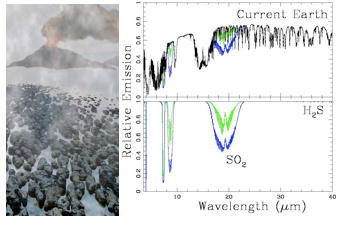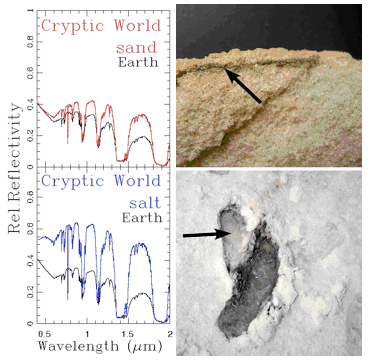2009 Annual Science Report
 Massachusetts Institute of Technology
Reporting | JUL 2008 – AUG 2009
Massachusetts Institute of Technology
Reporting | JUL 2008 – AUG 2009
Modelling Planetary Albedo
Project Summary
What kind of environments could provide opportunities for life in general and for the advent of complex life specifically to emerge? If there were complex life present, what features would it produce? Could we remotely characterize such habitats and the features of complex life on extrasolar planets light-years away with current and future NASA missions?
These are the three main questions we work on in this part of the project.
Project Progress
LK & DS Worked on the global surface environment and remote detectability of terrestrial planets with alternative geochemical cycles (paper on atmospheric signatures of a SO2 cycle submitted). Enhanced concentrations of SO2 are clearly detectable with future NASA space missions. Sulfur dominated environments are of general interest as alternatives for the emergence of alien biochemistries both for early conditions for life as well as an environment for the advance of complex life (see Fig.1). In addition aerosols due to sulfur could affect albedos on such planets and influence the climate as well as the location of the Habitable Zone.
In a separate effort, in collaboration with Roger Fu and Richard O’Connell (Harvard EPS) DDS developed models of the dynamics of the interiors and LK developed models of detectable features of water dominated super-Earths (see Fig.2), the paper is submitted. In addition to the scientific publication this also created great interest in the media (even so unpublished for now) and was taken up by the History Channel as part of their Liquid Universe show (interviewing LK) as well as the Discovery Channel (interviewing DS).
LK in collaboration with Charles Cockell and John Raven (microbiologists UK) developed and published models for remotely detectable features of planetary environments that are dominated by cryptic photosynthesis (see Figure 3), quantifying the production of oxygen by cryptic photosynthesis on an earth-like exoplanet and assessing the remotely detectable features of such worlds for nest generation NASA space missions.
LK calculated and submitted papers on the detectability of simple and advanced life remotely on exoplanets as well as the influence of host stars on the potentially habitability of planetary environments. It also provides a step to step approach on how to characterize a habitable world with low to higher resolution measurements in accordance from future NASA mission concepts.

Figure 1. Fig. 1: Calculated reflection and thermal emission spectrum shown from 0.4μm – 40μm of a cloud-free atmosphere for Earth models with detectable features of the sulphur cycle (lower panels 1ppm (green) 10ppm (blue)) in low resolution (R = 150) (Kaltenegger & Sasselov 2009).

Figure 2. Fig. 2: Spectra of present-day Earth with a total ocean and snow cover world without (left) and with (right) clouds for a disk averaged view (Kaltenegger et al Astrobiology in press).

Figure 3. Fig. 3: Two examples of land-based cryptic photosynthetic communities. (top) a cryptoendolithic lichen (arrow) inhabiting the interstices of sandstone in the Dry Valleys of the Antarctic, (bottom) endoevaporites inhabit a salt crust visible as pink pigmentation (arrow) (photo: Marli Bryant Miller) and their respective calculated clear reflection spectra. Substrates represent typical habitats for different cryptic biota (Cockell, Kaltenegger & Raven 2009).
Publications
-
Cockell, C. S., Kaltenegger, L., & Raven, J. A. (2009). Cryptic Photosynthesis—Extrasolar Planetary Oxygen Without a Surface Biological Signature. Astrobiology, 9(7), 623–636. doi:10.1089/ast.2008.0273
-
Kaltenegger, L., & Sasselov, D. (2009). DETECTING PLANETARY GEOCHEMICAL CYCLES ON EXOPLANETS: ATMOSPHERIC SIGNATURES AND THE CASE OF SO 2. The Astrophysical Journal, 708(2), 1162–1167. doi:10.1088/0004-637x/708/2/1162
-
Kaltenegger, L., & Traub, W. A. (2009). TRANSITS OF EARTH-LIKE PLANETS. The Astrophysical Journal, 698(1), 519–527. doi:10.1088/0004-637x/698/1/519
-
Kaltenegger, L., Selsis, F., Fridlund, M., Lammer, H., Beichman, C., Danchi, W., … White, G. J. (2010). Deciphering Spectral Fingerprints of Habitable Exoplanets. Astrobiology, 10(1), 89–102. doi:10.1089/ast.2009.0381
- Fu, R., Sasselov, D. & O’Conell , R. (In Press). The Astrophysical Journal.
-
PROJECT INVESTIGATORS:
-
PROJECT MEMBERS:
Lisa Kaltenegger
Co-Investigator
Dimitar Sasselov
Co-Investigator
-
RELATED OBJECTIVES:
Objective 1.1
Formation and evolution of habitable planets.
Objective 1.2
Indirect and direct astronomical observations of extrasolar habitable planets.
Objective 4.1
Earth's early biosphere.
Objective 4.2
Production of complex life.
Objective 6.2
Adaptation and evolution of life beyond Earth
Objective 7.2
Biosignatures to be sought in nearby planetary systems